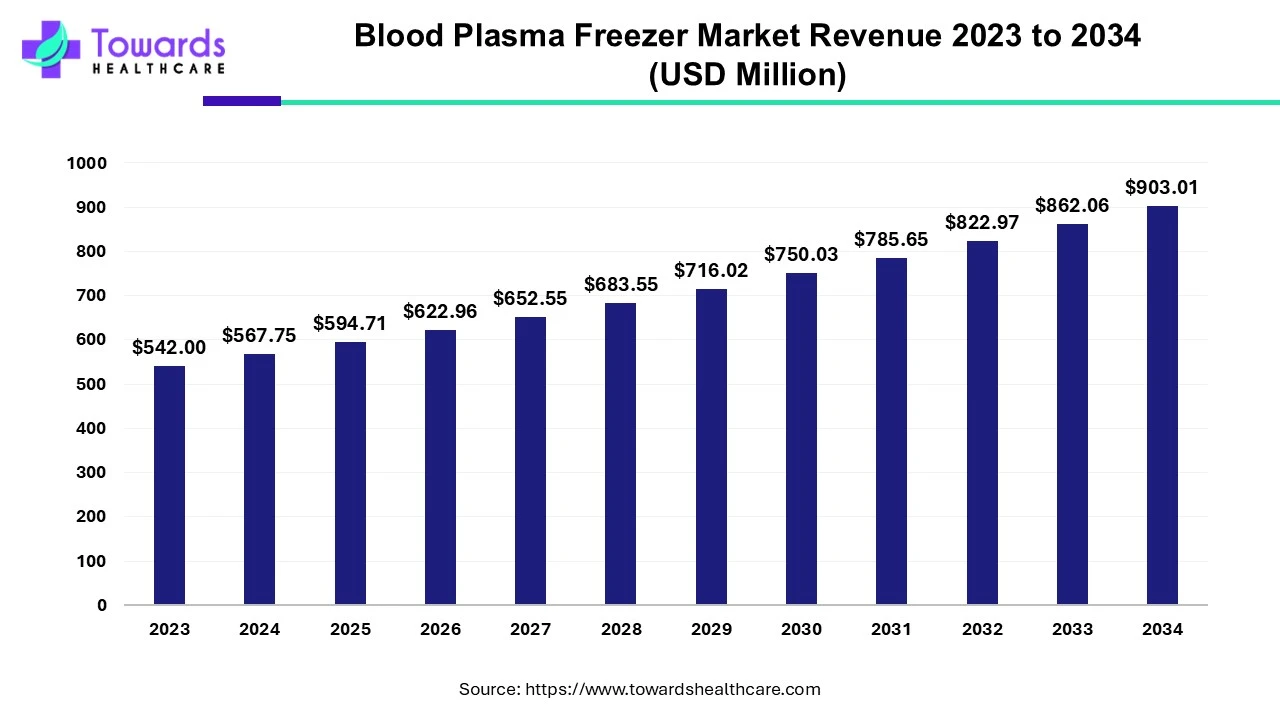February 2025

The global blood plasma freezer market was estimated at US$ 542 million in 2023 and is projected to grow to US$ 903.01 million by 2034, rising at a compound annual growth rate (CAGR) of 4.75% from 2024 to 2034. The demand for blood plasma freezer is increasing globally to maintain the freezing temperature of fresh frozen plasma, red blood cells, platelet concentrates and cryoprecipitate for safe storage which results in efficient treatments for patients dealing with blood clot-related diseases.

A blood plasma freezer is a specialized machine designed to maintain a stable, ultra-low temperature to preserve blood and blood plasma components. This medical storage unit is equipped with an advanced cooling system, which ensures the integrity of the stored sample. The application of the blood plasma freezer is observed at healthcare facilities and blood banks, and these sites are facilitated with cutting-edge features such as a secure locking mechanism and a safety alarm to protect the stored content. These valuable samples are commonly used for medical transfusions and research purposes. The blood plasma freezer is growing due to the increasing adoption at healthcare facilities and blood banks and the rising need to safely store critical blood components for an extended period. Moreover, the strict regulatory standards assure appropriate control and quality assurance of blood products.
The blood plasma freezer market is driven by the rising demand for blood and blood components and is anticipated to expand in the future as blood transfusion is required in complex medical and surgical interventions, which significantly improves the quality of life and increases the life expectancy of a patient. The clinical demand for blood and blood components is rising in healthcare facilities due to the need for timely availability of blood in case of emergency or selected procedure. Additionally, in the coming future, blood transfusion procedures will continue to grow with more focus on safety. The development of artificial blood from culture plates is expected to be witnessed. These genetically modified blood cells will be developed in the laboratories with the guidance of experts. In the next 10-15 years, there will not be any risk of transfusion, a neutral blood group, and no fear of alloimmunization.
For Instance,
Lack of awareness about blood donation restrains the blood plasma freezer market growth. Donated blood is essential for patients undergoing surgery, cancer treatment, traumatic injuries, accidents, chronic illnesses, and many more. This lack of awareness about blood donation is creating a hindrance to running out of resources and being unable to save lives and provide proper treatment. According to Red Cross Blood Donation, out of 38% of people in the U.S. eligible to donate blood, only 3 % donate. Due to this ratio, the supply never meets the required demand. As per the American Cancer Society, more than 1.9 million people were diagnosed with cancer in 2023 who needed blood during their chemotherapy treatment. As a result, people need to be educated about the benefits of blood donation; otherwise, this will continue to slow the blood plasma market growth.
For instance,
North America held the largest revenue share in the blood plasma freezer market in 2023. In North America, the market is characterized by the American Red Cross, the world’s largest supplier of blood, plasma, and tissue products. It supplies blood and blood components to almost half of the nation. The North American region has the leading laboratories for research and development purposes and to deliver essential diagnostic healthcare information to patients. The collaborative landscape of organizations, laboratories, and biopharma companies is witnessed among major countries such as the U.S. and Canada, which contribute to encouraging healthcare facilities and expansion of the blood plasma freezer market.
Asia Pacific is expected to expand at the fastest CAGR during the forecast period. In the Asia Pacific, the market is experiencing robust growth and novel innovations with the help of leading companies. This region is working on enhancing the existing facilities and ensuring that patients are provided with reliable and quality blood samples. Asia Pacific aims to make transfusion medicine and biotherapies sales available and effective on a global scale.
By type, the manual defrost segment led the blood plasma freezer market by holding the largest market share. It is anticipated that a manual defrost freezer is the best choice for storing certain sensitive biological materials. Manual defrost is widely used due to its simplicity, low maintenance, and low energy consumption. The healthcare facilities are adopted highly due to their cost-effective and minimal operational expense feature.
By type, the automatic defrost segment is estimated to witness the fastest growth over the studied period. The demand for automatic defrost is rising in the blood plasma freezer market due to its minimal temperature fluctuation during the defrost cycle and eliminates the need to move the sample which leads to no hampering with the sample.
By application, the hospital segment dominated the blood plasma freezer market in 2023. The rising demand for ease of availability of blood samples in hospitals in case of need drives the market in this segment. A high-performance freezer is required in hospitals to preserve the quality of blood and its medical effectiveness.
By application, the laboratory segment is anticipated to experience significant growth during the forecast period. This is due to the increasing demand for blood and blood components to undergo testing and processing in the laboratory, which can later be used for storage or distribution purposes when needed.
By Type
By Application
By Region
February 2025
November 2024
December 2024
November 2024